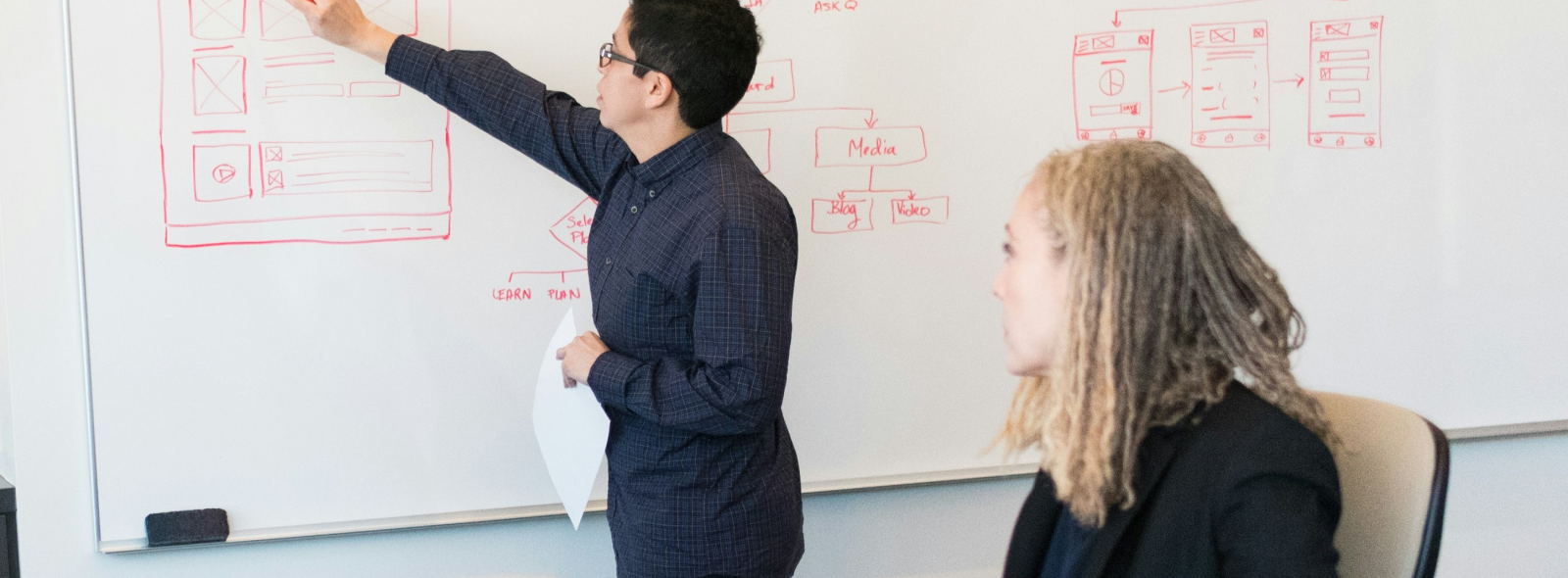Stepping into the realm of best enterprise UX design is like unlocking a door to efficiency and innovation in the corporate world. With each click and interaction, large companies are redefining how their teams work smarter, not harder.
Now imagine this: streamlined workflows that save time, interfaces so intuitive they practically read your mind, all while handling complex tasks with ease. This isn’t just good business; it’s smart design at its finest—design that thinks for you before you even realize you need it.
As we delve deeper together, expect to uncover strategies that engage users by cutting through cognitive overload without stripping away power features essential for heavy-duty enterprise software use.
Enterprise UX Design Fundamentals
The best enterprise UX design is all about making the complex simple. Big businesses have big needs, and their software has to keep up without causing headaches. We’re talking power users here—people who use these apps every day, and whose time is too precious for bad UX.
“Don’t Make Me Think”: Simplifying User Interactions
Ever heard of Steve Krug’s famous “Don’t Make Me Think”? It hits home in enterprise environments where you can find yourself drowning in data or lost in navigation mazes. The key? Clarity over complexity. A Material Design approach, for instance, might be just what your design team needs to bring that consumer UX magic into an enterprise application addressing enterprise challenges.
Simpler interactions mean less time fumbling through menus and more time crushing business goals. That’s good news because nobody wants their brain doing gymnastics while trying to complete mundane tasks at work.
Power Users and Niche Software
Niche software isn’t like your everyday app store download—it’s tailor-made for specific industries and comes with a steeper learning curve than most are used to dealing with on their phones or personal computers. But once mastered, it becomes second nature; almost like riding a bike but with way more buttons.
This is why we talk about cognitive load—a fancy term meaning how much mental effort something requires from us—as being higher when using professional tools versus playing around on social media apps during lunch breaks. Understanding user behavior and designing interfaces that meet them halfway can save everyone some gray hairs (and valuable hours).
.png)
The Learning Curve in Enterprise Environments
Enterprise UX design strikes a fine balance between intuitive navigation and the learning curve necessary for mastering complex systems. Users often grapple with sophisticated software that demands more than just basic understanding. It’s about enabling users to climb that learning curve, ensuring they come out on top, ready to tackle their tasks with greater efficiency.
Embracing Complexity with Caution
In enterprise settings, power users thrive within feature-rich environments. Yet, it’s crucial not to oversimplify interfaces as this can inadvertently strip away valuable functionality these seasoned professionals rely on. Cognitive load is real; too much simplification risks patronizing experienced users who expect depth from their tools. A thoughtful design approach recognizes when user interactions should be streamlined and when complexity serves a purpose.
This delicate dance isn’t just about aesthetics—it directly impacts operational productivity gains which are non-negotiables in large organizations. Consider how an expert pianist needs a full piano keyboard rather than a simplified version—this analogy rings true for enterprise applications where nuanced control leads to symphonies of productivity.
An interface requiring some degree of learning can result in heightened performance once mastered—a truth many enterprises witness firsthand as they see their teams grow more adept over time using robust platforms designed specifically for them. Exploring the history and future of such interfaces sheds light on why we must sometimes build roads less traveled by but undoubtedly leading towards innovation and enhanced capabilities.
We needn’t shy away from asking our professional users to learn something new if it means better results down the line—the payoff speaks volumes through improved workflows and satisfied clients relishing the fruits borne from those initial steep climbs toward mastery.Scaling design thinking takes into account both human capacity limits while also pushing boundaries ever so gently towards expansive horizons awaiting beyond comfort zones.
Key Takeaway:
Mastering complex enterprise UX design helps users tackle tasks more efficiently, balancing intuitive use with necessary complexity. Keep it smart without dumbing down—power users need depth to work their magic.Craft interfaces that grow skills and boost performance. Think of them like pianos for pros—the right keys unlock productivity symphonies. Don’t fear the learning curve; it leads to innovation and happier clients.
Non-Linear User Journeys in Enterprise Systems
When it comes to enterprise software, one size doesn’t fit all. Users expect flexibility that aligns with their unique workflows and decision-making processes. That’s where non-linear flows come into play, offering a tailored experience that respects individual usability requirements.
Think about the way you navigate your favorite streaming service. You’re not forced down a single path; instead, you can jump between genres or search directly for what interests you—a perfect example of accommodating diverse user expectations within digital platforms.
In an enterprise setting, this freedom is even more critical because users are often dealing with complex tasks and data sets that don’t follow a straight line. It takes time to fine-tune such systems but get it right, and watch as mundane tasks transform into streamlined operations—saving precious time along the way.
The Importance of Adapting to User Expectations
User journeys in large companies’ applications must mirror real-life scenarios where decisions aren’t always sequential. For instance, consider how operational efficiency improves when AR technology allows engineers to leapfrog traditional steps by overlaying information on physical equipment—no need for cumbersome manuals.
This isn’t just good business sense—it’s essential for wider adoption among those who use these tools daily. By enhancing user experiences (like this one the Autism Voyage) through design solutions that acknowledge varied approaches to task completion, enterprises engage users more effectively than ever before.
Tackling Usability Requirements Head-On
A deep dive into user behavior uncovers patterns beyond linear progression which any good enterprise UX designer knows should shape software design principles accordingly. While animated illustrations may catch user attention momentarily, understanding historical context, and current trends provide invaluable insights leading toward intuitive navigation paths suitable for power users and novices alike.
If there’s anything certain about UX strategy within large enterprises today, it’s never boring. Design teams constantly find creative ways like integrating AI technology, to anticipate needs ,and preempt obstacles ,before they become roadblocks. Because at its core, great enterprise UI lets people do their jobs better without getting bogged down by bad UX—that’s something worth aiming for every day.
Key Takeaway:
Enterprise UX thrives on non-linear journeys, offering users the flexibility to navigate complex tasks in a way that suits them best. Like skipping through genres on a streaming service, good design lets enterprise users skip unnecessary steps and dive straight into what matters—making their work faster and more intuitive.
Innovation vs. Familiarity in Enterprise Software Design
Striking the right balance between fresh innovation and comfortable familiarity is a tightrope walk in enterprise software design. Users crave engaging interfaces but cling to familiar patterns, making this dance one of delicate moves.
Embracing Innovation While Respecting Tradition
Innovative features have the power to transform mundane tasks into experiences that captivate enterprise users. But too much change can send seasoned pros running for the hills—or at least back to their old spreadsheets. So designers must weave advanced features like AI technology into enterprise solutions with care, ensuring they don’t just dazzle but also deliver operational efficiency.
An innovative approach might see AR technology enhance user training programs without overhauling time-tested processes, creating a bridge between what’s known and what’s next. This keeps users engaged while respecting their mastery of current systems—acknowledging that good business hinges on both cutting-edge tech and reliable outcomes.
Familiar Interfaces: The Backbone of User Confidence
No matter how shiny new tools are, if they’re not built on intuitive navigation grounded in familiar interfaces, they’ll likely fail to win wider adoption among enterprise clients. Remember when animated illustrations popped up everywhere? They grabbed attention but sometimes left users wondering how to actually get things done.
A smart strategy here involves leveraging behavior design principles that mirror everyday activities—a nod towards cognitive ease even as we push boundaries with emerging UX trends like predictive analytics or virtual assistants which save time by streamlining workflows within complex systems.
Cultivating an Intuitive Path Through Change
It takes time for any organization large or small—to adapt its collective muscle memory to new ways of working; hence why designers need a keen understanding of non-linear user journeys through these ever-evolving landscapes where every click should feel natural yet potentially full of surprise and delight.
This balancing act isn’t just about knowing your user—it’s about growing with them as you introduce innovations step-by-step into your existing ecosystem. Because ultimately it’s all about keeping those clicks coming—innovatively sure—but more importantly intuitively so.
Key Takeaway:
Find the sweet spot between new and known in enterprise UX to keep users hooked without overwhelming them. Smart design weaves cutting-edge features into familiar workflows, making tech both exciting and reliable.Keep it intuitive—use familiar interfaces as a base for introducing innovative tools that streamline work without causing confusion. That way, you’ll guide users through change with confidence, balancing novelty with ease of use.
Best Practices for Enhancing Enterprise User Experience
Good business solutions hinge on enhancing user experience, especially in the enterprise realm. The secret sauce? Marrying usability with complex business needs.
Imagine an orchestra where every musician knows their part perfectly—the result is harmony. That’s what good enterprise UX does; it orchestrates a seamless interaction between users and software.
“Don’t Make Me Think”: Simplifying User Interactions
To engage users effectively, you need to embrace Steve Krug’s principle: Don’t make me think. Clarity wins in the land of Material Design principles, guiding enterprise design towards intuitive navigation that feels as natural as flipping through a magazine.
The idea is simple—keep things clear and direct so power users can focus on productivity, not puzzling over perplexing interfaces. After all, nobody wants to decode hieroglyphics when they’re crunching numbers or analyzing data.
Innovation vs. Familiarity in Enterprise Software Design
Innovation sounds exciting but sprinkle it with familiarity for that comfort food effect—a dash of newness mixed with the warmth of well-known flavors keeps experienced users coming back for more.
Balancing cutting-edge features like AI technology or AR training programs with familiar touchpoints makes sure everyone’s onboard—even your most tech-wary team members. You don’t want them feeling like they’ve been teleported onto an alien spaceship every time there’s a software update.
So, what’s the smart move here? It’s all about balance. Stick with proven strategies but don’t shy away from new ideas—think of it as evolving your toolkit rather than ditching it for the latest fad. By blending stability with creativity, you’ll make changes that are welcomed instead of resisted.
.png)
Trends Shaping Modern Enterprise UX Design
Staying ahead in the enterprise game means embracing new trends that reshape how users interact with software. AI technology is now a game changer, transforming enterprise solutions into smarter, more adaptive tools. Imagine an assistant who not only knows your preferences but also anticipates your needs—this is what integrating machine learning can achieve for user experiences.
The Rise of AI and Machine Learning
By weaving AI into the fabric of enterprise applications, we’re seeing platforms that not only respond to commands but learn from them. This leads to interfaces tailored to individual workflows, boosting operational efficiency like never before. It’s about giving power back to the users—letting their behavior shape their software environment.
And let’s talk data—big data isn’t just buzzworthy; it’s vital for enhancing user experience through personalization. With analytics diving deep into usage patterns, design teams are crafting creative solutions aimed at streamlining workflows and engaging users more effectively than ever.
The Impact of Augmented Reality on Training and Operations
Mundane tasks? They’re taking a backseat as AR technology brings a new dimension to training programs within enterprises. We’re looking at virtual overlays that guide workers through complex operations—a leap towards intuitive navigation in environments where time-consuming mistakes aren’t an option.
An immersive approach makes sure training sticks—it’s one thing reading about a process; it’s another experiencing it virtually step by step. Through this lens, even seasoned professionals find room for improvement because augmented reality doesn’t just simulate—it enhances real-world scenarios for better decision-making on the fly.
.png)
Leveraging Case Studies and Resources for Improved Enterprise UX
Ever noticed how the best enterprise UX designs feel like they read your mind? That’s no accident. It comes from companies diving deep into user insights and research to understand what you, as an enterprise user, really need. And when these insights lead to design solutions that reduce cognitive load—boom—you’ve got software that not only works but also delights.
Take a look at some of our own projects where we analyzed key elements in our clients’ workflows. We found that by tailoring the design to fit specific user requirements, users could accomplish tasks more efficiently than ever before. This is because good business hinges on great UX—it’s all about making every click count.
If you’re looking for inspiration or proof that this approach works, don’t just take my word for it; check out this video exploring the history and future of enterprise UI/UX. You’ll see real-world examples where complex systems have been transformed into intuitive platforms even your grandma could use (no offense to tech-savvy grandmas).
In another example of industry evolution through intelligent design, Wired discusses how DevOps influences modern UX strategies, proving yet again why keeping up with development trends matters in creating cutting-edge enterprise applications.
To wrap it up without actually wrapping it up—because who needs conclusions anyway—the right case studies can be gold mines of knowledge. They help us gauge which strategies save time while enhancing user experiences across various industries. So go ahead: dig into those resources and let them guide your next big design move.
.png)
The Role of Data Analytics in Refining User Experiences
Data analytics isn’t just a buzzword; it’s the secret sauce that turns bland enterprise software into a Michelin-star experience for users. Imagine diving deep into user behavior, and you’ll find patterns more intricate than your grandma’s knitting. Big data gives us the lowdown on what users love and loathe, helping to craft personalized experiences as comfy as an old pair of jeans.
Turning Numbers into Narratives
We’re not talking about dry spreadsheets or yawn-inducing graphs here. By analyzing heaps of data, designers can weave stories that pinpoint exactly where users hit roadblocks faster than a GPS avoiding traffic jams. It’s like being psychic but with loads of data instead of crystal balls.
User insights gained from this digital telepathy let teams create interfaces that speak to folks’ needs before they even have to ask—now how’s that for service? And when you personalize these experiences based on real-time feedback, it’s like giving each user their own personal butler who knows whether they prefer Earl Grey or Oolong tea without them uttering a word.
Making Smarter Design Decisions
Here’s where things get juicy: big data doesn’t just help us understand current trends—it also lights up the path forward with neon signs saying “This way.” We’re talking predictive models that are savvier at forecasting UX improvements than weather apps are at predicting rain in Seattle (which is always).
Leveraging historical and future-facing insights, enterprises can design solutions so intuitive, your dog could probably figure them out—with enough treats involved. This levelality transforms mundane tasks by simplifying complex operations while still catering to power-users craving advanced features—the UX equivalent of having cake and eating it too.
Key Takeaway:
Big data turns enterprise software from bland to grand, offering a comfy user experience that’s tailored just for you. By turning numbers into narratives, we’re making design psychic—anticipating your needs like a personal butler who knows your tea preference without asking.Weaving stories from data lets us dodge UX roadblocks and light up the path with insights so sharp, they predict your next move better than a weather app predicts Seattle rain—which is pretty darn often.
Cultivating a Stronger Design Culture Within Enterprises
Creating an internal culture that breathes design thinking is more than just adopting new tools or holding creative workshops. It’s about fostering a mindset where user-centric development becomes second nature, and every team member values the role of design in achieving business success.
User-Centric Development at Its Core
A robust enterprise UX strategy pivots on understanding that your users—be they customers or employees—are humans first. This human-first approach goes beyond mere aesthetics; it’s about crafting experiences that make people feel empowered and efficient. By prioritizing intuitive navigation, enterprises can reduce cognitive load, making complex tasks less time-consuming and mundane workflows more engaging.
The heart of cultivating such a culture lies in encouraging empathy among your teams—a commitment to truly grasp the needs and challenges faced by enterprise users. Whether through direct engagement or immersive analytics, insights gained from real-world interactions lead to solutions tailored for genuine problems.
Innovation Anchored in Familiarity
While embracing advanced features like AI technology or AR for operational efficiency might be tempting, balance is key. Good enterprise UX doesn’t throw out the rulebook—it rewrites it with respect for existing behavior designs while still pushing boundaries. Remember: innovation should enhance user experience without alienating those accustomed to traditional interfaces.
Leveraging case studies from successful implementations helps illustrate how blending creativity with practicality leads to wider adoption within large companies—because good business hinges not only on what’s new but also on what works seamlessly. Scaling design thinking, after all, isn’t about reinventing the wheel; it’s refining its roll towards better horizons.
.png)
Conclusion
Stepping up your game in best enterprise UX design is crucial. You’ve seen how intuitive navigation and streamlined workflows aren’t just nice to have; they’re essentials that redefine efficiency.
You learned the power of “Don’t Make Me Think” in complex software, ensuring even niche users find value every day. Balancing learning curves with productivity? It’s an art form here.
Remember, advanced tech like AI can transform user experiences from mundane to cutting-edge. And let’s not forget research—it shapes everything you do by tuning into real user needs.
Your takeaway? Design smartly for those at the helm of enterprise tools. Streamline their tasks, meet varied requirements, and keep pushing usability boundaries for better engagement and innovation.




